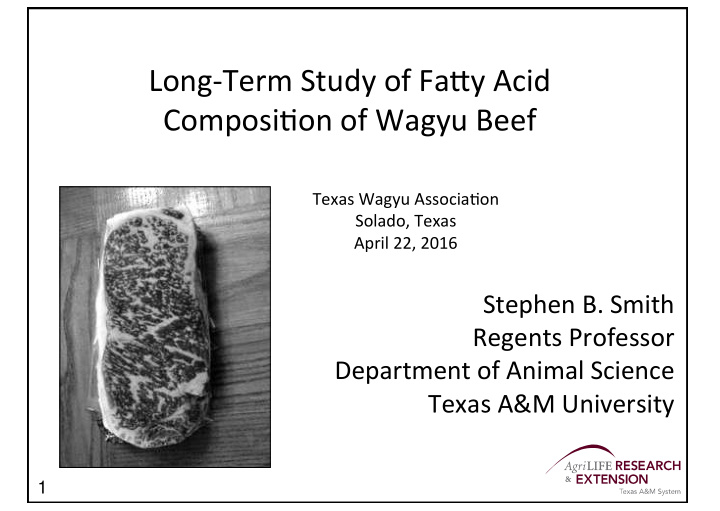



Long-Term Study of Fa9y Acid Composi@on of Wagyu Beef Texas Wagyu Associa@on Solado, Texas April 22, 2016 Stephen B. Smith Regents Professor Department of Animal Science Texas A&M University 1
The healthful fa9y acids in beef Oleic acid Conjugated 18:1c9 linoleic acid 18:2c9,t11 • Oleic acid – The most abundant fatty acid in most beef • Linoleic acid Linoleic acid 18:2c9,c12 – Most comes from plant oils • Conjugated linoleic acid – Small amounts in beef • α -Linolenic acid (omega-3 fatty acid, not shown) – Small amounts in beef (even grass-fed) 1 2
Pasture feeding increases saturated and trans -fats in beef steaks. • Grain-fed beef has twice as much oleic acid as beef from grass-fed ca9le. • Grass feeding increases saturated and trans -fa9y acids. 3
Typical composition of the ground beef used in our four human trials • Ground beef from grass-fed is high in saturated and trans - fatty acids. • Ground beef from corn-fed cattle is high in oleic acid. • Omega-3 fatty acids were very low in all ground beef types. ! 3 4
Eating ground beef decreases carbohydrate intake and increases fat intake. • Men and women changed their eating patterns. • They reduced carbohydrate intake when they ate more ground beef. 5
Carbohydrate intake versus fat intake • As we consume more fat we consume much less carbohydrates. • I consider this to be a healthy approach. 6 5
ーン How do we change the fatty acid composition of beef? • We compared Angus and Wagyu steers fed corn-based or hay-based diets. • Cattle were fed to 1,100 lb or 1,400 lb. 7 marbling scoreは コーン給与の日 本の最終目標重 量まで育てた和 牛が高かたです
Corn-based and Hay-based diets コ ーン ベスえさ ヘイベスえさ Corn-based diet Hay-based diet • 89.1% dry matter • Steers had free • 11.2% crude protein access to hay and • NE m = 1.81 Mcal/kg pasture. • NE g = 1.19 Mcal/kg • Corn diet was added • Target = 3 lb/d ADG. to provide 2 lb/d ADG. 7 8 marbling scoreは コーン給与の日 本の最終目標重 量まで育てた和 牛が高かたです
Varia@ons in the MUFA:SFA ra@o for ground beef 一価不飽和 飽和 Types of ground beef • The MUFA:SFA ratio is the ratio of monounsaturated 脂肪組織中 fatty acids (mostly oleic acid) to は月齢により saturated fatty 上昇しました acids. • High-quality beef 日本の方法の h has a high MUFA:SFA ratio 給与の和牛は一 (greater than 1.2). 番 があ りました 9 それけれど SCD活 性はhay給与のア ンガス牛では上 昇しませんでした
The MUFA:SFA ra@o 一価不飽和 脂肪酸 飽和 脂肪酸 increased in adipose @ssue with age. 脂肪組織中 MUFA/ SFA は月齢により 上昇しました 日本の方法の h ay 給与の和牛は一 番 MUFA/SFA があ りました 9 10 それけれど SCD活 性はhay給与のア ンガス牛では上 昇しませんでした
• The longer ca9le are on feed, the lower the lipid mel@ng points. • Corn-fed ca9le produce fat with lower lipid mel@ng points than hay-fed ca9le. • Hay-fed Wagyu steers had the lowest lipid mel@ng points. 11
In beef, lipid mel@ng points are determined by the amount of stearic acid. • Fat depots differ widely in their amounts of stearic acid and melting points. • Wagyu beef and domestic brisket have very low amounts of stearic acid and low melting points. 12 11
Overall Fa9y Acid Composi@on 50 45 40 35 Omega-3 fa9y acids 30 25 Chicken breast 20 Salmon filets 15 Wagyu steaks 10 5 0 Palmi@c Palmitoleic Stearic Oleic Linoleic Linolenic EPA DHA All samples containing saturated and monounsaturated fa9y acids. Wagyu beef contains the highest percentage of oleic acid. Fish are high in EPA and DHA. 13
Total saturated, monounsaturated, and polyunsaturated fa9y acids (percent of total lipid) 60 50 40 Total SFA 30 Total MUFA Total PUFA 20 10 0 Chicken breast Salmon filet Wagyu strip steak 13 14
How do the current samples stack up? 55 50 45 J. Black 1992 40 Wagyu 1992 35 30 Wagyu 1993 Angus long-fed 25 Angus short-fed 20 Wagyu 2015 15 10 5 Palmi@c Stearic Oleic Samples from Japanese Black A5 had the highest oleic acid (> 50%), but beef from Wagyu ca9le raised in the U.S. consistently contains approximately 45% oleic acid. 15
Where do we go from here? • Wagyu beef represents a potential gold mine. – Marbling provides the flavor and juiciness beef eaters crave. – Oleic acid provides proven health benefits. • Wagyu beef may be the true answer to grass- fed beef. – Grass feeding will increase omega-3 fatty acids (great for perception). – Grass-fed Wagyu beef may contain more oleic acid than grass-fed beef from conventional cattle. 15 16
What’s next for me? • Next week I am presenting “Marbling and Its nutritional impact on risk factors for cardiovascular disease” to the Korean Society for Food Science and Animal Resources. – The are discussing changing Korean Hanwoo beef to lower total fat. – This will decrease oleic acid in Hanwoo beef. 17
Thank you! • Please contact me at sbsmith@tamu.edu 17 18
Recommend
More recommend